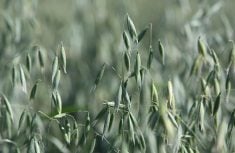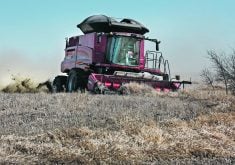Know your hay
When marketing hay, producers should know the type, composition and weight of bales.
“If selling hay is likely an every-year occurrence, building up a relationship with repeat buyers makes the process a whole lot easier,” said Allan Macaulay, forage specialist with Alberta Agriculture.
“Probably the first thing producers should consider is the type of bale they have for sale. The type of bale available, large round, small round, square or small square, has a direct bearing on the market open for consideration.
Read Also

VIDEO: Ag in Motion documentary launches second season
The second season of the the Western Producer’s documentary series about Ag in Motion launched Oct. 8.
Small square bales can be handled by hand and have a significant advantage in the small holding market or specialized operations. Small round bales are too expensive to haul any distance, but may be fine for short haul.”
Producers should know the weight, composition and the moisture content of the bales.
Just as farmers wouldn’t sell livestock or grain without a weight on it, hay needs to be weighed. This is best done by hauling a few bales to a scale or borrowing a scale with a platform and getting a reading on the variation between bales and figuring out an average weight.
“Make sure the hay is dry – between 14 and 15 percent moisture. Hay at a higher moisture may not keep properly and can get dusty or even rot,” said Macaulay.
“Let the customer know up front the condition and composition of the hay. If it has had some rain on it, let the buyer know. Things such as composition, percentages, rain exposure and price per bale or per ton should all appear on the bill of sale.”
Increase confidence
Customer confidence increases when bales are uniform and well-shaped. It is a sign that care and attention have been given the product. Wrap the bales properly and adequately. There is a correlation between the number of wraps and the ability to shed water.
“If a producer is trying to capture the top end of the market, the hay bales should be tarped,” he added. “Tarping should be done so that air can still get into the stack and clear condensation away. Use specialized hay tarps and keep them tight.”
Feed testing for specialty markets, dairy in particular, can mean a better return. Analysis should be done for moisture, acid detergent fibre and protein. ADF is very important as it tells how digestible the hay is. Lower ADF is better for milking and growing cows and there is less waste.
“The more weed-free hay is, the better,” he said. “Some weeds are a big problem, tansy and scentless mayweed for example. If these weeds are present, be sure to tell the buyer and again, list it on the bill of sale.
“Don’t leave anything to chance,” said Macaulay. “Know the market you want to attract and actively pursue it. If you have dairy quality hay, let the dairy producers know you have what they need. If you have hay the alfalfa plants would want, a list of these plants is available from the local Alberta Agriculture forage specialist. Know what you’ve got and market it accordingly.”
There are a couple of internet sites where hay, straw and feed can be listed for sale.
Alberta Agriculture’s site at www.agric.gov.ab.ca has hay lists in the General Store section.
Saskatchewan’s AgInfoNet at www.aginfonet.sk.ca has a spot for listing bales for sale under the Buy/Sell heading.
Saskatchewan Agriculture also has a feed grain and forage listing service at 1-800-667-7564.
– Alberta Agriculture














